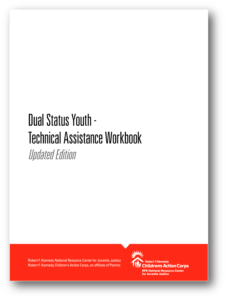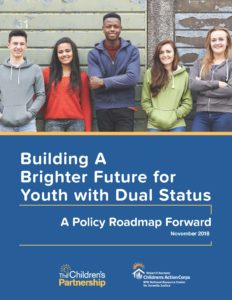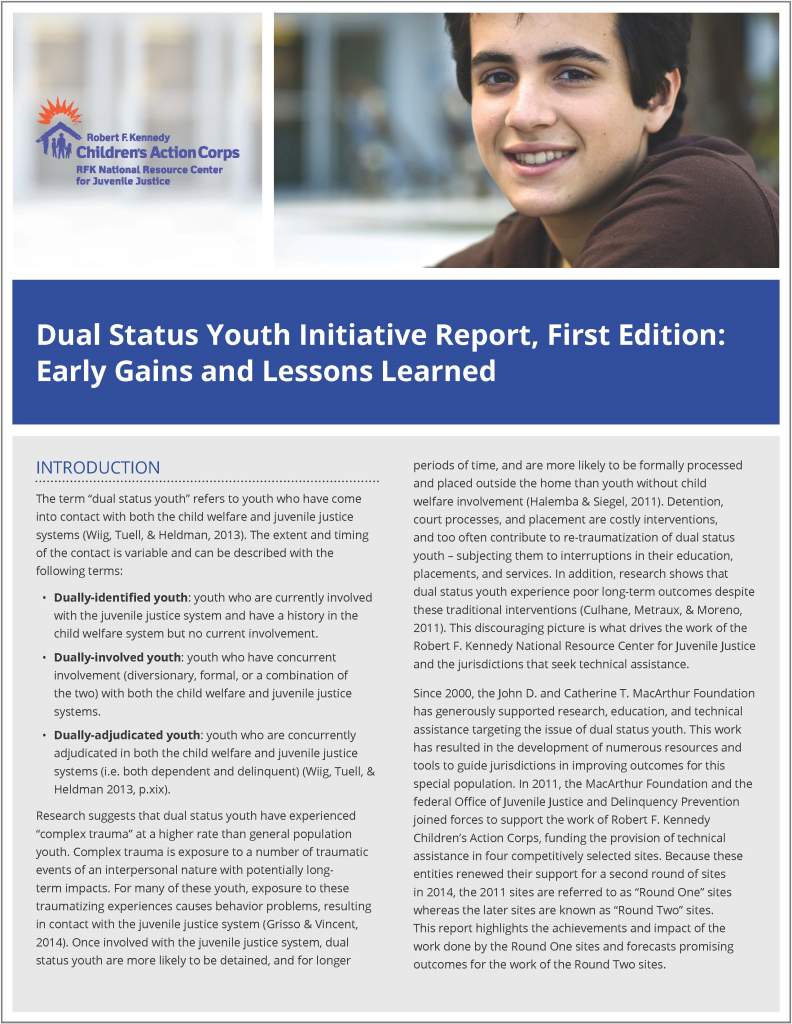Resources
Click here to return to the main Resources page. Jump to Jurisdictional Examples of Resources and Tools.
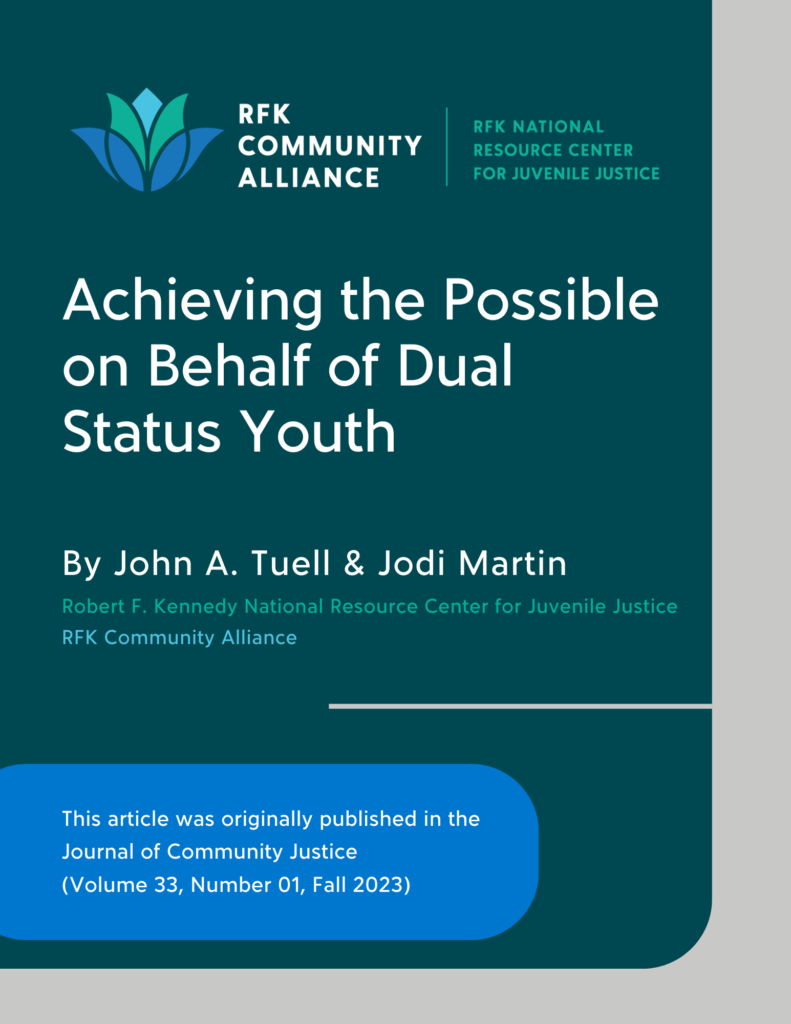
Achieving the Possible on Behalf of Dual Status Youth
John A. Tuell and Jodi Martin, Journal of Community Justice (Volume 33, Number 01, Fall 2023)
This article, published in the Journal of Community Justice (Vol. 33, No. 01, Fall 2023), reviews the research on dual status youth programs and describes specific RFK National Resource Center collaborations with initiatives in four Ohio counties. The Ohio Supreme Court, in partnership with the RFK National Resource Center, has modeled how state level support in collaboration with local jurisdictions can produce highly effective, research-informed, replicable practices to improve outcomes for dual status youth in participant jurisdictions. This approach has the potential to produce exponential gains that literally save the future of dual status youth and reduce the historical duplication of resources in an atmosphere of strained service availability.
This article can be accessed for free online through the Civic Research Institute Online Catalog.
Dual Status Youth — Technical Assistance Workbook, Updated Edition
Robert F. Kennedy National Resource Center for Juvenile Justice, 2021
This workbook provides practical guidance for state and local jurisdictions in their endeavor to improve outcomes for dual status youth and their families. Like its predecessor, this workbook serves as a companion piece to the Guidebook for Juvenile Justice and Child Welfare System Coordination and Integration: A Framework for Improved Outcomes, Third Edition (2013), and presents a month-by-month outline of analytical tasks, expectations, products, and timelines that frame the structure of a dual status youth initiative. The updated Technical Assistance Workbook provides access to a wealth of practical new examples of replicable products (e.g., Memoranda of Understanding, information sharing agreements, procedural narratives, multi-disciplinary team structure and operations, system performance and outcome measures, data collection and reporting methods, among others) that will support state and local jurisdictions seeking to undertake this important work.
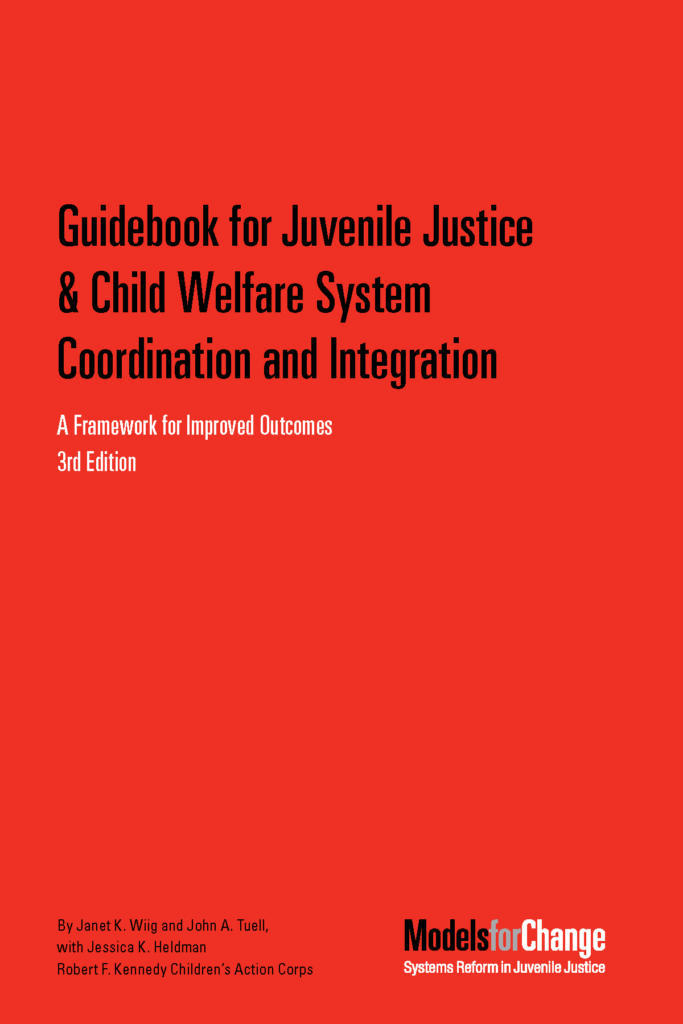
Guidebook for Juvenile Justice and Child Welfare System Coordination and Integration: A Framework for Improved Outcomes, 3rd Edition
Janet K. Wiig and John A. Tuell, with Jessica K. Heldman, Robert F. Kennedy Children’s Actions Corps, 2013
Built from years of collaborative expertise and experience, this Guidebook uses a comprehensive framework to guide state and local jurisdictions in achieving greater system coordination and integration for children, youth and families that populate multiple youth serving systems. The Guidebook highlights current research, best practice, and numerous examples from jurisdictions across the country that have worked to develop new practices, policies, procedures and protocols that will serve to improve the outcomes for multi-system children, youth and their families. The Guidebook is joined with a supporting publication, Dual Status Youth – Technical Assistance Workbook, Updated Edition (2021), designed to be used in conjunction with the Guidebook to advance the development of policy and practice for dual status youth.
Additional Resources
Supplementary Publications, Resources, and Guides
Building a Brighter Future for Youth with Dual Status
The Children’s Partnership & Robert F. Kennedy National Resource Center for Juvenile Justice, 2018
Our roadmap outlines useful policies, practices, tools, and frameworks supporting jurisdictions improve outcomes for youth with dual status. Our recommendations not only highlight the challenges we are facing, as evidenced by the findings but also offer valuable insights for what more can be done to improve the experiences of youth with dual status. In promoting collaboration, innovation, and a culture shift, these recommendations seek to create a more responsive and equitable approach to support the healthy development of youth with dual status.
Dual Status Youth Initiative Report, First Edition: Early Gains and Lessons Learned
Robert F. Kennedy National Resource Center for Juvenile Justice, 2016
Through the support of the John D. and Catherine T. MacArthur Foundation and the federal Office of Juvenile Justice and Delinquency Prevention, the RFK National Resource Center led two rounds of 12-month initiatives undertaken in eight jurisdictions, known as the Dual Status Youth Technical Assistance Initiatives. This report highlights the challenges, achievements, and impact of the work done by the first four (“Round One”) sites and forecasts promising outcomes for the work of the subsequent four (“Round Two”) sites.
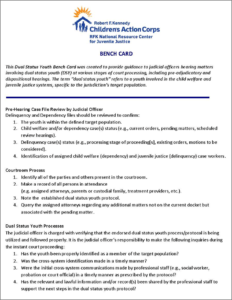
Dual Status Youth Bench Card
Robert F. Kennedy National Resource Center for Juvenile Justice, 2017
This Dual Status Youth Bench Card was created to provide guidance to judicial officers hearing matters involving dual status youth (DSY) at various stages of court processing, including pre-adjudicatory and dispositional hearings.
Jurisdictional Examples – Resources and Tools
1) Memorandums of Understanding (MOU) – DSY Initiative and Data & Information Sharing
DSY/DIY Coordination MOU Examples:
- Clark County, Ohio – between Clark County’s Juvenile Court and Department of Job and Family Services (PDF)
- Lancaster County, Pennsylvania – among Lancaster County’s Children & Youth Agency, Juvenile Probation Office, and Court of Common Pleas (PDF)
- Newton County, Georgia – multi-system MOU to improve the coordination of services, policies and practices among Newton County’s youth-serving systems (PDF)
- Saint Croix, US Virgin Islands – multi-system MOU to ensure improved performance outcomes for youth involved, or at-risk for involvement, in St. Croix’s dependency and delinquency systems (PDF)
Data and Information Sharing MOU Examples:
- Fulton County, Georgia – among Fulton County Juvenile Court, GA Department of Juvenile Justice, and the GA Department of Human Services, Division of Family and Children Services (PDF)
- Hampden County, Massachusetts – among Hampden County Juvenile Court, Department of Youth Services, Department of Children and Families, and Hampden County District Attorney (PDF)
- Marion County, Indiana – between Marion County Juvenile Probation Department and the Indiana Department of Child Service (PDF)
- Ottawa County, Ohio – between Ottawa County’s Department of Job and Family Services & Juvenile Court (PDF)
- Outagamie County, Wisconsin – between Outagamie County’s Child Youth & Family Services and Children Youth & Families (PDF)
2) Data Planning in the DSY Initiatives – WorkGrid (PDF)
3) Process Mapping Exercise – Introduction (PDF)
4) Multidisciplinary Team (MDT) Referral and Report Forms
5) Management, Resource, and Training Exercises
6) Dual Status Youth Initiative: Outagamie County Outcome Report Design (PDF)

